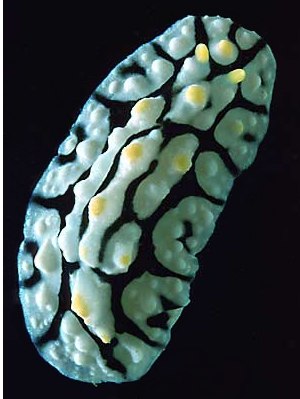
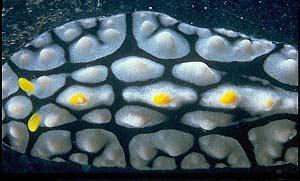
Phyllidia multifaria
Yonow, 1986
Order: NUDIBRANCHIA
Suborder: DORIDINA
Superfamily: EUDORIDOIDEA
Family: Phyllidiidae
DISTRIBUTION
Red Sea
PHOTO
UPPER: Whale Bay, Gulf of Aquaba. Jan 1980. Photo: B.E.Picton - illustrated in Yonow, 1988 as P. multifaria.
LOWER: 9 m depth, Whiskey Reef, Red Sea, 14 Jan. 1983, dorsal view of P. multifaria, 30 mm specimen, Photo: N. Yonow (Brunckhorst, 1993: Plate 2A).
The photos alongside were both identified by Yonow (1988) as typical of the species. Ventrally it has a black median longitudinal line on the sole of the foot.
This species was synonymised by Brunckhorst (1993) with Phyllidia elegans but see Bernard Picton's message suggesting that P. multifaria is a valid species and that Phyllidia schupporum Fahrner & Schrödl, 2000 is an unnecessary synonym.
References:
• Yonow, N. (1986) Red Sea Phyllidiidae (Mollusca: Nudibranchia) with descriptions of new species. Journal of Natural History, 20(6): 1401-1428.
• Yonow, N. (1988) Red Sea Opisthobranchia 1: The family Phyllidiidae (Mollusca, Nudibranchia). Fauna of Saudi Arabia, 9: 138-151.
Rudman, W.B., 2002 (July 2) Phyllidia multifaria Yonow, 1986. [In] Sea Slug Forum. Australian Museum, Sydney. Available from http://www.seaslugforum.net/find/phylmult
Related messages
Phyllidia multifaria ? from the Persian Gulf
May 4, 2010
From: Mahdi Moradi Och Tapeh
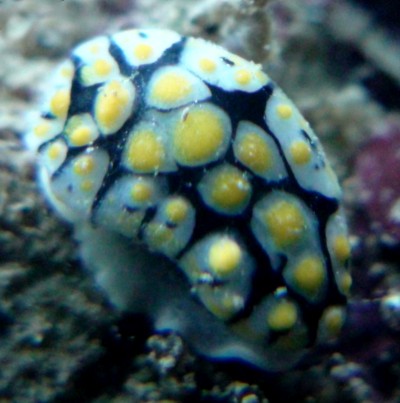
During my researches on Coral Reef in Persian Gulf I found this species on coral Reef bed in Larak & Qeshm Island, and I need to your guidance about identification and biology information of this species?
Locality: Larak Island- Bandar Abbas , 3-8 m , Iran , Persian Gulf , 4 May, Rocky bed. Length: 2-4 cm . Photographer: Omid Alizade .
Best Regard
Mahdi Moradi
biologymoradi@gmail.com
Moradi, M., 2010 (May 4) Phyllidia multifaria ? from the Persian Gulf. [Message in] Sea Slug Forum. Australian Museum, Sydney. Available from http://www.seaslugforum.net/find/23599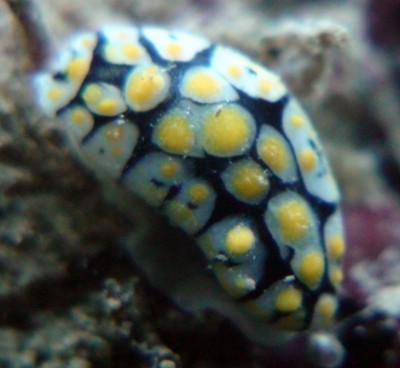
Dear Mahdi,
This is a phyllidiid dorid. Unfortunately there are still some issues with the identification of phyllidiids, the most difficult being our inabiity to determine just how many species there are. Your specimen looks very like Phyllidia multifaria, a species which at present is known only from the northern Red Sea. There is another 'species' known only from the Red Sea, P. schupporum, which also looks very similar, but as is discussed on the Forum, it is most probably the same as P. multifaria.
Another possibility is Fryeria rueppelii, but in that species there is usually a yellow border around the mantle edge, and the anus opens below the mantle skirt.
My best guess is that this is P. multifaria, which would suggest it has a wider distribution than just the Red Sea.
Best wishes,
Bill Rudman
Phyllidia multifaria ? from the Red Sea
April 21, 2008
From: Eddy Mannak
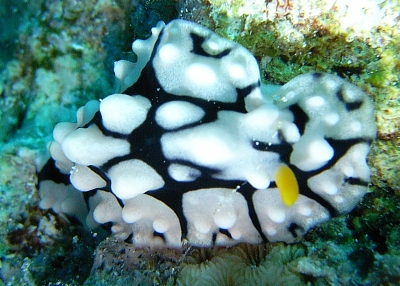
Dear Bill,
I did take this photo last June when I was on a diving holiday in Egypt. I did saw there a lot of nudibranchs like always and most of them I did determine my self already. But by this one I need some help.
The picture is not really good, but I still hope you can see what you need to see for determine this nudibranch. Underwater I take a quick shot from this nudibranche because I thought that it was a Fryeria rueppelii. And I saw that several times before and have also some nice pictures of them. Later at home when I was looking to the pictures I saw that there was no yellow at the end of the mantle. And I mean that is one of the chararistics of Fryeria rueppelii. But if it is not a Fryeria rueppelii what is then?
Locality: Hurghada, 20 metres, Egypt, Red Sea, 24 June 2007. Length: 30-40 mm. Photographer: Eddy Mannak.
So if I do not know which species it is I always look at the Seaslug Forum to find it out. From the pictures I saw on the Seaslug Forum I would see that it is probably a Phyllidia elegans. But I'm not sure of that and therefore I need some more help. So please can you determine this species for me.
Greetings from Holland,
Eddy Mannak
eddy.mannak@wanadoo.nl
Mannak, E., 2008 (Apr 21) Phyllidia multifaria ? from the Red Sea. [Message in] Sea Slug Forum. Australian Museum, Sydney. Available from http://www.seaslugforum.net/find/20858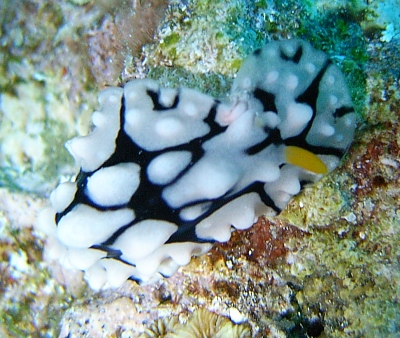
Dear Eddy,
Phyllidia elegans might be the correct answer but I am afraid some of the phyllidiids still need a lot of work. There is also the possibility that this is Phyllidia multifaria, but if you look at earlier discussions on the Forum there is some doubt about that species as well. I am tentatively identfying it as P. multifaria but not with great conviction.
Best wishes,
Bill Rudman
Phyllidia multifaria from the Red Sea
February 14, 2008
From: Annette Kliphuis
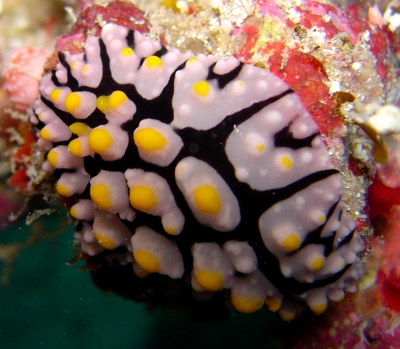
Dear Bill,
Inside a cave at Samadai reef (Red Sea) we found two specimens of what we believe is Fryeria rueppelii. Is this true? When I look at the Factsheet I see a clear yellow border around the mantle and these guys don't have that. Also the smaller of the two (lower picture) has only 3 yellow dots on its body, where the larger one is covered in it. Is the smaller one a juvenile?
Also they were both sitting on the bottom on rocks covered in what we believe are pink sponges (or ascidians?). Can you help me identifying these slugs?
Locality: Samadai (west, inside the cave), 5 metres, Egypt, Red Sea, 26 November 2007, Inside a cave on rocks covered with pink sponges (?). Photographer: Marieke Koopmans & Tim Jacobs.
Thank you in advance!
groeten,
Annette
Annette.Kliphuis@wur.nl
Kliphuis, A.M.J., 2008 (Feb 14) Phyllidia multifaria from the Red Sea. [Message in] Sea Slug Forum. Australian Museum, Sydney. Available from http://www.seaslugforum.net/find/21268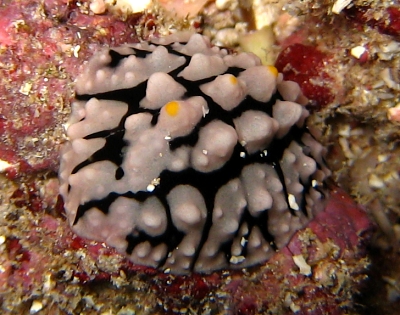
Dear Annette,
I am pretty sure this is Phyllidia multifaria, but if you have a look at the Fact Sheet you will see there is still some debate about whether it is a 'good' species or not. Sometimes, when there are not a lot of anatomical or colour differences to separate species, it take some years before new names are accepted or rejected. That is why photos like yours can be helpful in building up a file of information on some of these 'rarer' species - which may turn out to be common species from rarely reported places.
Best wishes,
Bill Rudman
Phyllidia multifaria from Egypt
March 8, 2003
From: Marina Poddubetskaia
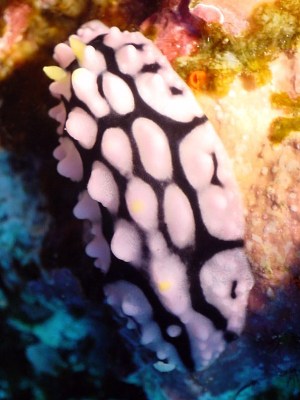
Dear Bill,
I found this specimen during my recent diving cruise to Brothers Islands. Could you confirm it is Phyllidia multifaria, please? Unfortunately, I wasn’t able to take photos of its ventral view because of the surge. But I remember, the foot was pale.
Date: February 13, 2003
Location: Marsa Alam, Egypt, Red Sea
Site: Elphinstone
Depth: 9m
Size: 30-35mm
Photos: Marina Poddubetskaia - Nembro website
Best wishes,
Marina.
nembro@nembro.info
Poddubetskaia, M., 2003 (Mar 8) Phyllidia multifaria from Egypt. [Message in] Sea Slug Forum. Australian Museum, Sydney. Available from http://www.seaslugforum.net/find/9245Dear Marina,
I'm afraid I can't confirm that it is P. multifaria. It certainly has the right colour markings dorsally but that species is supposed to have a black median line on the sole of the foot, and you say you remember the foot to be pale. I guess from that you have no recollection of a black line. At this stage I will tentatively identify it as P. multifaria but I am open to suggestions
Best wishes,
Bill Rudman
Phyllidia multifaria from Egypt
September 27, 2002
From: Michael Mrutzek
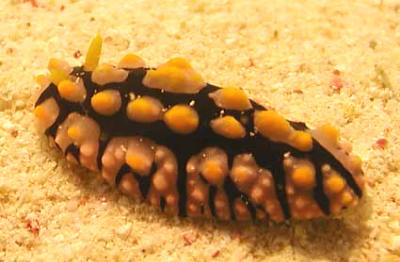
Dear Bill,
Here is a photo of another slug from the Red Sea for use in the Forum.
Data: Outside of Disha Reef, off Hurghada, Red Sea coast of Egypt, August, 2002, 10 Meters. Photo: Copyright Michael Mrutzek.
Michael
Mrutzek@meeresaquaristik.de
Mrutzek, M., 2002 (Sep 27) Phyllidia multifaria from Egypt. [Message in] Sea Slug Forum. Australian Museum, Sydney. Available from http://www.seaslugforum.net/find/8033Dear Michael,
This looks quite like Phyllidia elegans but I will follow Bernard Picton's message and identify it as Phyllidia multifaria.
Best wishes,
Bill Rudman
Fahrner & Schrodl's Phyllidia schupporum
July 4, 2002
From: Bernard Picton
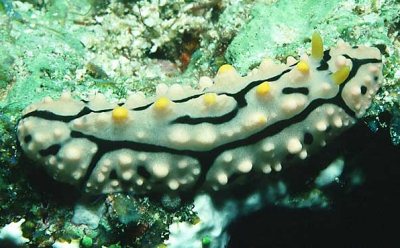
Dear Bill,
Following my earlier comments on Fahrner & Schrodl's paper redescribing Phyllidiopsis sinaiensis I would like to make some comments on their Phyllidia schupporum. It is clearly the same as Yonow's P. multifaria which Brunckhorst synonymised with P. elegans. I've attached some scans of Red Sea P. multifaria and Malaysian/Indonesian P. elegans. I think Brunckhorst was wrong to synonymise these species and Fahrner and Schrodl have now confused the situation further by redescribing P. multifaria as P. schupporum.
Consistent differences between P. multifaria and P. elegans seem to include much taller, compound mid-dorsal tubercles in P. elegans; the smaller tubercles in P. elegans are bright white - contrasting with ground colour of mantle, whilst in P. multifaria they are coloured almost the same as the mantle.
UPPER RIGHT: - 12 Dec 1992 - Sharm el Sheik, Egypt
LOWER LEFT: - 13 Dec 1992 - Jackfish Alley, Sharm el Sheik, Egypt
LOWER RIGHT: - Jan 1980 - Whale Bay, Gulf of Aquaba - (illustrated in Yonow, 1988 as P. multifaria)
• Fahrner, A. & Schrödl, M. (2000) Description of Phyllidia schupporum, a new nudibranch species from the northern Red Sea (Gastropoda, Nudibranchia, Phyllidiidae). Spixiana, 23(1): 55-60.
Bernard
bernard.picton.um@nics.gov.uk
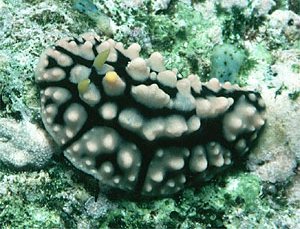

Thanks Bernard,
Yonow's P. multifaria certainly looks like Fahrner & Schrödl's Phyllidia schupporum. One thing I notice in Fahrner & Schrödl's description is that they specifically state that there are no characteristic markings on the sole of the foot. Yonow describes a median black line on the sole of P. multifaria and this character also appears in P. elegans. P. schupporum was described from a single preserved animal, the colour information apparently based on photographs. It is possible therefore that if there was a black median line on the foot, it could have dissolved in the preservative. Describing new species, especially in such a problematic group as the phyllidiids, from a single specimen, is not a good idea.
I guess the big problem is still to decide whether Brunckhorst was right in considering P. multifaria to be a synonym of P. elegans.
Cheers,
Bill
